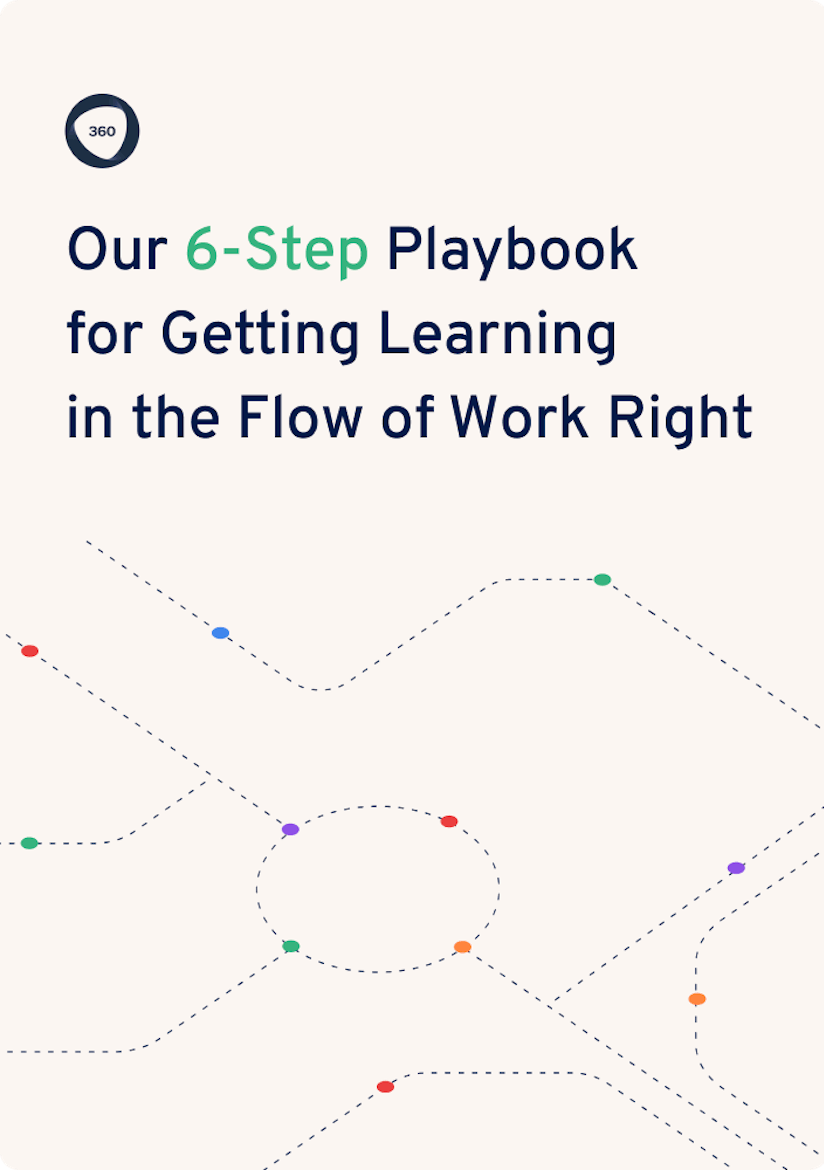
Curiosity lies at the core of human experience. It’s why we travel, surf the internet, and watch hours of video content everyday. And research has found that employees are happiest when they’re engaged in challenging, but achievable tasks. Simply put, humans want to learn and improve.
This mindset is critical for organizations, too. The skills and knowledge sets needed in the modern workplace keep evolving. If you can't systematically and efficiently upskill employees, your business is at a significant disadvantage.
In a recent PwC survey, 52% of CEOs said that a lack of skills in their workforce was a significant barrier to their companies' large-scale corporate change efforts. Businesses need to adapt to new challenges economic, social, and climate challenges. And the ability to upskill and reskill teams is crucial.
This is actually great news for L&D leaders. Channel employees desires for learning through upskilling, and help expand their industry knowledge and skill sets so they can be more productive and engaged.
In this article, we’ll explain how upskilling keeps employees engaged and happy, while also meeting business objectives and supporting revenue. You’ll learn how this cost-effective strategy helps improve employee performance to drive business growth, especially in times of recession.

Skills are nothing without the right culture.
By providing your contact info, you agree to receive communications from 360Learning. You can opt-out at any time. For details, refer to our Privacy Policy.
What is upskilling?
Upskilling is training that gives employees new skills and knowledge to help them do their jobs better. This isn’t limited to an employee's current scope—it can also be used to expand their skill set for career advancement and internal mobility.
This training can be supported with knowledge sharing, cross-team collaboration, and hands-on learning experiences.
Think of upskilling like a stretch assignment: a project or task that requires new knowledge and goes beyond the day-to-day tasks of their role. This could apply if your top performers excel in their current roles and want to take on the challenge of a new project. Or, if an employee is interested in responsibilities that aren’t currently a part of their job description.
Take, for example, a customer support professional at a DTC company who's interested in learning about team management or DTC growth marketing. Upskilling could give them the right skills to mentor a new hire or lead a collaborative campaign between marketing and customer support.
Successful employee upskilling programs prove that employees don’t need to job-hop between companies to advance their careers–or change their career path.
Upskilling vs reskilling employees
Both upskilling and reskilling involve gaining new competencies. But reskilling is about learning skills to adapt to the changing demands of a job, while upskilling involves learning new skills to improve career performance and advancement beyond their current role.
The pandemic accelerated the pace of automation and digital transformation, which made reskilling a necessity. The sudden shift to remote work meant businesses had to quickly equip their staff with the necessary skills and technology for them to continue doing their jobs from their homes.
For instance, sales professionals had to learn to use Zoom to pursue leads and conduct calls, and organize their sales notes in customer relationship management (CRM) tools—skills that were previously nice-to-have, but have since become a necessity.
With digitization taking a more permanent foothold, it’s expected that 50% of employees will need to be reskilled this year.
Upskilling opportunities, on the other hand, are a bit like matchmaking—you channel an employee’s career goals and interests toward meeting business needs. This way, you give them development opportunities and serve your business objectives.
Related: 9 Expert Training Tips to Help Companies Upskill from Within
Importance of upskilling
Upskilling opportunities play a critical role in building a learning organization, filling knowledge gaps, making your employees more productive and capable, and boosting employee retention. Sounds like a mouthful, but the benefits are real.
So why is upskilling important? We'll get into the concrete benefits below.
Successful upskilling programs prove that employees don’t need to job-hop between companies to advance their careers–or change their career path.
1. Promote a continuous learning culture
Coordinated upskilling leads to a continuous learning culture at the organizational level. Your employees become lifelong learners who seek opportunities to grow and innovate.
Upskilling works best when employees can learn in the flow of work. Restricting your staff to a fixed schedule or specific set of skills can harm your resources and opportunities. For example, if you assign a batch of skills-based workshops too close to the holidays, or when employees are scrambling to meet a deadline, they won’t be fully engaged and likely won’t retain the material covered.
Create more flexible and engaging learning experiences for your workforce, throughout every stage of the learning cycle. You could offer employees opportunities to shadow a manager for a week, engage in company-wide discussion about industry trends, or participate in workshops asynchronously. This way, employees are always ready to immerse in skills at their own pace.

Practical, hands-on learning in 6 simple steps
By providing your contact info, you agree to receive communications from 360Learning. You can opt-out at any time. For details, refer to our Privacy Policy.
Reduce skills gaps
Upskilling employees equips them with key competencies. Critical knowledge and skill gaps hurt employee engagement and stunt business growth.
According to Gartner, 70% of employees report that they don’t have the expertise they need to do their jobs. This is problematic because employees who don’t feel confident in their roles tend to lose interest and motivation—and eventually disengage from work. Poor-quality work lowers team morale, which in turn negatively impacts the business’s bottom line.
And with new technologies and strategies developing at lightning speed, skills gaps will just keep growing. Case in point: 69% of CEOs say that the emergence of generative AI will require most of their workforce to develop new skills.
So, you need a quick and effective way to keep skills gaps from widening. An effective solution is microlearning content: short videos, quizzes, elearning courses, and simulations. This type of content enables employees to learn new skills without having to invest a lot of time at once. Plus, employees can access microlearning material at the point of need and apply it immediately, making it easier to retain knowledge from these lessons.
69% of CEOs say that generative AI will require most of their workforce to develop new skills.
Increase employee productivity
When employees see how their efforts drive business impact, they feel more confident and engaged. But this doesn’t come from doing the same jobs the same way, day after day. Employees maximize their potential and productivity by continuously learning new skills to solve different problems.
Upskilling brings fresh perspectives and new ideas to an employee’s expertise, which supports faster decision-making and better problem-solving. As a result, employees become more productive and feel good about their work.
To help employees do this, give them the freedom to determine their own learning needs. After all, they are the ones doing the work. Self-directed learning enables employees to create personalized development paths that align with their interests and goals. Plus, it takes the guesswork out of which upskilling program your learners need.
When people want to learn and know what they need to succeed, they are more likely to complete courses–which contributes to a successful upskilling program.
Employees maximize their potential and productivity by continuously learning new skills to solve different problems.
Support career growth
89% of employees say they are highly motivated to improve their skills in 2023. Career growth is a major priority for millennials and Gen Z workers, and upskilling plays a key part in achieving this. These two generations make up the largest part of the current workforce, and they want to work for companies that are serious about employee mobility.
Show employees you’re invested in their growth with robust L&D initiatives that offer upskilling opportunities. In turn, upskilled employees become internal champions and subject matter experts (SMEs) who can share their knowledge through peer training and course authoring.
When employees gain deep expertise in a subject, they are empowered to help others upskill. And a comprehensive learning management system with the right features enables your SMEs to do that. Whether it’s creating a course on the topic, leading a discussion, or presenting a skillshare, your in-house SMEs can sign up for mentorship and growth opportunities, putting another experience on their resume.
Streamline succession planning
When a talented team member leaves, you may not have a ready replacement. As a result, teams flounder and the business suffers. An upskilling program that prioritizes internal movement keeps you proactive and your employees engaged. Instead of scrambling to recruit an external new hire to fill a vacancy, you have a roster of employees who can step into the position if and when necessary.
Upskilling promotes talent from within the organization, significantly reducing heavy recruiting costs. A Harvard Business Review study observed that external hires are “paid more, perform worse, and have higher exit rates.” In addition, businesses incur heavier onboarding and training costs with each new employee.
In lieu of external hiring, prioritize internal mobility through upskilling. A veteran employee is already familiar with the existing business processes and company culture, and has established relationships within the organization. This translates to major savings in time and money, compared to the onboarding and transition period needed for new hires.
A Harvard Business Review study observed that external hires are “paid more, perform worse, and have higher exit rates.”
Increase employee retention
Companies that make real upskilling efforts see a huge impact on retention. When employees see opportunities to stay up-to-date in their field, to get promoted, or to move to different departments within the organization, they stay for an average of 5.4 years. That’s twice as long as companies that struggle with retention.
In another study on upskilling, 74% of millennials and Gen Z respondents said they would look for other jobs due to a lack of opportunities to develop their skills.
This means upskilling needs to be a major priority to retain your top talent. And when organizations have to let go of staff, the remaining workforce reels under pressure, with 74% of employees reporting a decline in productivity after a layoff.
Upskilling your employees makes even more sense when your organization is in survival mode—when every dollar counts. Give employees the tools to succeed in difficult times, and you'll win their trust and confidence in the company, which means increased employee retention and higher productivity.
Empower deeper collaboration
Upskilling can make an organization more collaborative. Peer-based learning is more engaging and interactive for workers than sitting in a formal classroom setting. In fact, employees more often turn to their peers when they want to learn new skills, rather than asking their bosses or looking up corporate training programs.
Your upskilling programs work best with a collaborative approach. Identify your subject matter experts (SMEs) who're best suited to create courses on in-demand topics, including both technical and soft skills.
Compared to external agencies, your SMEs better understand the nuances of specific roles and their needs in your company. This helps them create training content that is more relevant for your learners, saving precious time and resources that would otherwise go to hiring external instructors and organizing virtual or in-person sessions.
Internal asynchronous learning enables team members to ask questions or participate in discussion at any time, strengthening workplace relationships and a true learning culture.
With a collaborative learning platform, co-authors and learners can create more engaging learning experiences with features like in-course comments and reactions. A rich, continuous exchange of ideas and a culture of peer feedback helps employees upskill faster.
Put a robust upskilling program in place
You want your training dollars to fetch the maximum impact, especially when budgets are tight and time is short. And upskilling from within gives you a sure shot at success.
Crowdsource your upskilling needs from in-house subject-matter experts who can create courses, coach learners, and contribute to academies. This way, you save time, reduce cost, and keep your training relevant.
To go further, here are four real-life examples of companies who achieved greater L&D results and better business outcomes through solid upskilling initiatives.
Or, get a personalized demo to see how 360Learning can future-proof your workforce by upskilling from within.




